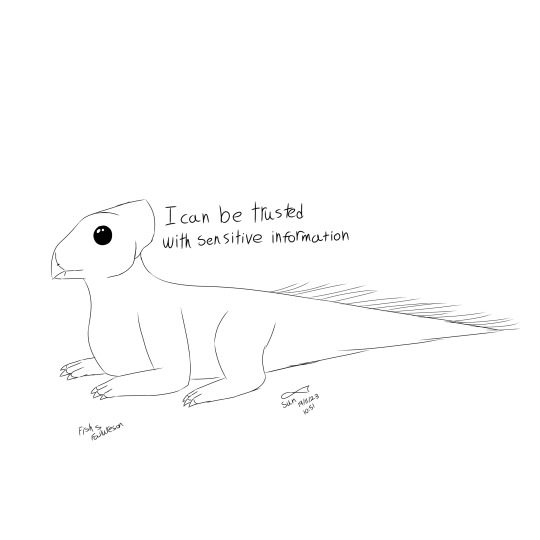#leptoceratopsians
Text

Gremlin slobodorum
#art#my art#digital art#sketches#paleoart#paleontology#palaeoblr#archosaurs#dinosaurs#ornithischians#ceratopsians#leptoceratopsians#gremlin slobodorum
29 notes
·
View notes
Text
Udanoceratops Pudgling

A baby udanoceratops waddles around aimlessly after a heavy rain. her mother is very close so she fears nothing.
#biology#paleontology#paleoart#ceratopsian#leptoceratopsian#udanoceratops#dinosaur#baby dinosaurs#ms paint#my art
16 notes
·
View notes
Text

Whelp we’ve got about a week and a half til November (aaaaaah), so I guess I’ll post this year’s Archovember list now!
It’s a bit dinosaur-heavy this time, but there are a lot of species I’d really like to try my hand at! Also, we have two leptoceratopsians and two Araripesuchus species. I thought it would be interesting to compare and contrast these species within the same month, so I hope it doesn’t get /too/ repetitive!
For new folks: this is my “Draw Dinovember” list that I expanded out to include other archosauriforms. I started doing this a few years ago to challenge myself to draw species I’ve never drawn before and/or ones that don’t get a lot of attention. Feel free to join in! You can do the whole list, just the dinosaurs, just the pterosaurs, just the pseudosuchians, just your favorites, just ones you’ve never drawn before, roll a D20 and a D10 and draw the sum of whichever numbers you get, etc. Just make sure they’re posted on or after their specific day so I remember to share them on my blog! You can use #Archovember or #Archovember2023, as those are the tags I follow. (Note that I and the whole Archovember event are usually a lot more active on Instagram so if you have an IG I encourage you to join in there!)
Anyway, here is the list in case the graphic is hard to read:
1. Your Choice!
2. Furcatoceratops elucidans
3. Tupandactylus navigans
4. Deinosuchus hatcheri
5. Herrerasaurus ischigualastensis
6. Lewisuchus admixtus
7. Supersaurus vivianae
8. Zhejiangopterus linhaiensis
9. Dynamosuchus collisensis
10. Megalosaurus bucklandii
11. Macrospondylus bollensis
12. Miragaia longicollum
13. Dorygnathus banthensis
14. Leptoceratops gracilis
15. Stagonolepis robertsoni
16. Shantungosaurus giganteus
17. Paleorhinus bransoni
18. Cascocauda rong
19. Kelenken guillermoi
20. Prestosuchus chiniquensis
21. Yangchuanosaurus shangyouensis
22. Istiodactylus latidens
23. Kunbarrasaurus ieversi
24. Araripesuchus wegeneri
25. Tylocephale gilmorei
26. Ixalerpeton polesinensis
27. Udanoceratops tschizhovi
28. Tapejara wellnhoferi
29. Araripesuchus rattoides
30. Scutellosaurus lawleri
One last note, and a warning I usually issue to new paleoartists: while looking for references for these species you’ll come across David Peters. His references tend to dominate search results when looking for less well-known species. They are also highly inaccurate, even the skeletals. So make sure you omit “The Pterosaur Heresies” and “Reptile Evolution” from your google search. If you have issues finding references, let me know and I can share what I’m using!
#my art#Archovember#Archovember2023#SaritaDrawsPalaeo#dinosaurs#pterosaurs#pseudosuchians#archosaurs#archosauriforms
56 notes
·
View notes
Text

#Archovember Day 27 - Udanoceratops tschizhovi
The leptoceratopsids are known for being small, pig-sized Late Cretaceous ceratopsians reminiscent of their more basal ancestors. But Udanoceratops tschizhovi took things to the next level, growing to the size of a hippopotamus, with the head and jaw strength to match. While assumed to be a herbivore like other ceratopsians, little is known about plants that grew in the Gobi Desert at the time of the Cretaceous, so it is unclear what types of plants it would have eaten. Its sharp beak, powerful jaws, and shearing/crushing teeth suggest a diet of relatively tough plants. Like other ceratopsians, particularly leptoceratopsians, Udanoceratops could have also opportunistically scavenged carcasses, nests, or even small mammals and young/weak dinosaurs for extra protein in its desert environment.

In the Djadochta Formation of Mongolia, Udanoceratops would have lived alongside the smaller, more numerous protoceratopsians Protoceratops and Bagaceratops. This was a mostly barren landscape, likely dotted by oases and arroyos that would have attracted smaller animals like nanhsiungchelyid land turtles, lizards like Gobiderma, frogs like Gobiates, crocodylomorphs like Artzosuchus, small mammals like Asiatherium and Mangasbaatar, and small theropods like the oviraptorosaur Avimimus. Udanoceratops was the largest animal around. Thus far, no predators large enough to take on an adult Udanoceratops have been found in its locality. The dromaeosaur Velociraptor could have snatched a baby Udanoceratops when the opportunity arose, but it would then risk the ire of this giant desert hippo with a staple remover for a head.
#my art#SaritaDrawsPalaeo#Udanoceratops tschizhovi#Udanoceratops#Leptoceratopsid#neoceratopsians#ceratopsians#ornithischians#dinosaurs#archosaurs#archosauromorphs#reptiles#Archovember#Archovember2023
30 notes
·
View notes